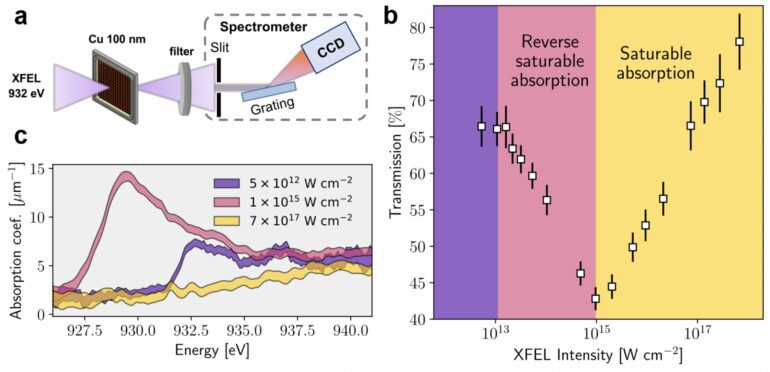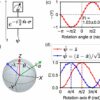Experiments at European XFEL generate states of matter that are close to what occurs in the interior of planets or in the imploding capsule of an inertial fusion reactor. At the same time, they open up a way to measure ultra-short phenomena.
Exploring the extreme conditions reached in the interior of planets, including Earth, or during a fusion reaction, is a major challenge. By focusing the extremely powerful X-ray laser of European XFEL on a copper foil, researchers have created and investigated a state of matter very far from equilibrium, coined warm dense matter (WDM), that resembles such exotic environments.
Their findings make remarkable strides in understanding and characterizing this elusive state of matter, which is crucial for advancing inertial confinement fusion, a process that holds promise for clean and abundant energy. The research is published in the journal Nature Physics.
Heat can drastically change the state of matter. Depending on the temperature, substances are solid, liquid or gaseous. In a certain temperature range, matter also assumes a state known as warm dense matter (WDM): it is too hot to be described by the physics of condensed matter, but at the same time too dense for the physics of weakly coupled plasmas.
The boundary between warm dense matter and other states of matter is not precisely defined. Often a temperature range of 5,000 Kelvin to 100,000 Kelvin is specified at pressures of several hundred thousand bar, whereby one bar corresponds to the air pressure on Earth’s surface.
WDM is not stable in our daily environment and is very difficult to produce or even examine in the laboratory. Typically, scientists compress samples in diamond anvil cells to reach high pressures, or use powerful optical lasers to turn solids into WDM for a tiny fraction of a second.
The intense X-ray pulses of European XFEL have now proved to be a very useful tool for generating and analyzing warm dense matter. The researchers used copper as a sample material. “The high intensity of the pulses can excite the electrons in the copper foil to such an extent that it switches to the state of warm dense matter,” explains Laurent Mercadier, a scientist at the SCS instrument who led the experiment. “This can be seen in a change in its light transmission.”
A metal that is irradiated by an intense X-ray pulse can become transparent if the electrons in the metal absorb X-ray energy so fast that there are no electrons left to excite. The remaining tail of the pulse can then penetrate the material unhindered. This is known as saturable absorption (SA).
Conversely, a metal can become increasingly opaque if the front of the pulse creates excited states that have a higher absorption coefficient than the cold metal. The tail of the pulse is then absorbed stronger, an effect known as reverse saturable absorption (RSA). Both processes are routinely used in optics, for example, to generate a specific pulse length with lasers.
The researchers at European XFEL have now irradiated sharply focused, 15 femtosecond-long X-ray pulses onto a 100 nanometer-thick copper film. They then analyzed the transmitted signal using a spectrometer.
“The spectrum heavily depends on the intensity of the X-ray pulse,” explains Mercadier. “At low to moderate X-ray intensity, copper becomes more and more opaque to the X-ray beam and exhibits RSA. However, at higher intensities, absorption saturates and the foil becomes transparent.”
These drastic alterations of opacity happen so fast that the atomic nuclei in the metal do not have time to move. “We are dealing with a very exotic state of matter where the lattice is cold and some of the ionized electrons are hot and are not in equilibrium with the remaining free electrons of the metal,” explains Mercadier.
“To account for this, we developed a theory that combines solid-state and plasma physics.” For the researchers, the change of opacity is a sign that they have succeeded in creating and characterizing warm dense matter in the laboratory.
Understanding material opacity under these extreme conditions is urgently needed for inertial confinement fusion. In the latter, intense energy is used to compress and heat a fuel target, creating conditions necessary for fusion. Opacity determines how much radiation energy is absorbed or transmitted through the material, which is essential for ensuring that the energy used for compression does not escape, allowing for efficient fusion reactions.
Short is not short enough
“Actually, these effects happen so fast that we need even shorter X-ray pulses to fully resolve the electron dynamics,” says Andreas Scherz, head scientist at the SCS instrument. “Recently, the European XFEL has demonstrated the capability to generate attosecond pulses, thus opening a door to the so-called attosecond physics.”
With attosecond X-ray pulses one could precisely ‘film’ the movement of electrons during the formation of warm dense matter or during chemical reactions, and thus significantly improve our understanding of, e.g., chemical processes or the functioning of catalysts.
The 2023 Nobel Prizes in Physics awarded to the French-Swedish physicist Anne L’Huillier, the Hungarian-Austrian physicist Ferenc Krausz and the French-American physicist Pierre Agostini show that this is an extremely topical research subject.
More information:
Laurent Mercadier et al, Transient absorption of warm dense matter created by an X-ray free-electron laser, Nature Physics (2024). DOI: 10.1038/s41567-024-02587-w
Provided by
European XFEL
Citation:
When copper becomes transparent: European XFEL creates exotic matter (2024, July 29)



